











Gentlemen Don't Read Other Gentlemen's Mail
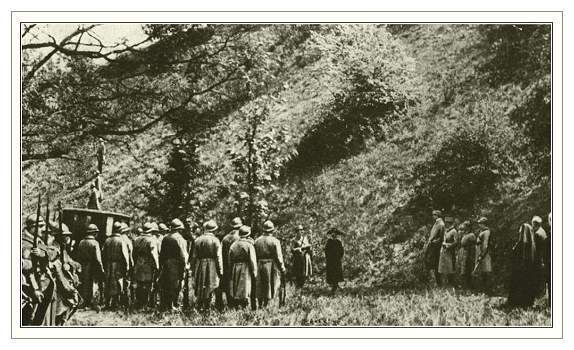
The Execution of Mata Hari in 1917
The best known 'spy' during the Great War was undoubtedly Margaretha Zelle, a dutchwoman better though less accurately known as Mata Hari. Even now it is difficult to decide what the poor woman's real role was in the events for which she was sentenced to death. Was she guilty of spying or was she just guilty of being a naive and light headed lady ? The files on her trial in France are closed until 2017 so it may be a while yet before anything can be said with certainty. Whatever the case, her story has inspired many a book and movie and will no doubt continue to do so.
In the early days of the war, before and just after the Battle of the Marne, it would be no exagerration to say that France, Great Britain and even 'brave little' Belgium were beset by a spy mania of serious proportions. People saw spies everywhere. Anyone with the misfortune of having a German name was doubly at risk of being arrested, locked up, interrogated and accused of spying. Anyone acting 'suspiciously' in the vicinity of military installations or army encampments, anyone caught 'counting' trains or paying too much interest in troops marching by was in risk of being hauled in and charged with spying.
Undoubtedly some of these people were guilty as charged, but more than likely the majority were not. Most probably had the misfortune of simply looking and acting suspicious and being unable to talk themselves out of their predicament. They often paid for it with their lives.
The Germans were convinced that they faced a nation in arms when they invaded Belgium and France. Everyone was a potential franc-tireur in their imagination and they responded in a brutal and frightful manner. Executions of hostages and civilians were nothing out of the ordinary, whole villages and cities were put to the torch : Visé, Dinant, Aerschot, Louvain, Termonde are but a few of the towns that suffered widespread destruction and loss of life.
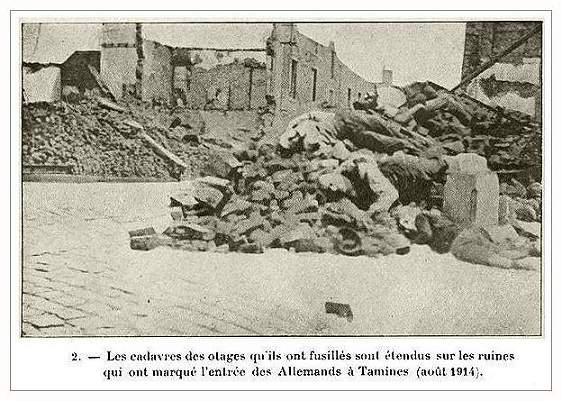
Belgian hostages shot at Tamines in August 1914
And on the Eastern Front it seemed that the fighting was even more savage and relentless. Numerous 'spies' and 'traitors' were executed, sometimes in wholesale lots en masse. The Austrian army was just as uncompromising and heartless when it came to executions.
In the following pages you will see a gallery of photos and illustrations having to do with spying and treason during the Great War. Few of the images make for light hearted viewing. In fact most are downright horrendous and chilling and are not suitable for young viewers or those easily shocked by the sight of death. Some photos are from well known newsmagazines such as the French weekly 'L'Illustration' or from popular British newsweeklies. It is a sign of the times that such publications reproduced photos of executed 'spies' with captions attesting to editorial approval. This was certainly a refection of the popular mood during the Great War.
On the other hand there are many photos taken from the anti-militarist publication 'Krieg dem Kriege' (1924) published by Ernst Friedrich. His two volume book contains a collection of horrific and grisly photographs that illustrate very graphically death and suffering during the Great War. Aside from photos of dead, wounded and mass graves, the publication also contains a number of photos showing executions of 'spies and traitors'. Most of these photos were taken on the Eastern Front and show Austrian, Bulgarian and German troops carrying out the grisly business of hanging, garroting and shooting by firing squad. Though several of these photographs are official war photographs made by the military authorities, most were probably made by individual soldiers as private souvenirs. Several of these were also issued as postcards, as hard to believe as that sounds. (see the following website : Propaganda Postcards of the Great War - go to 'Atrocities/Executions')
see also French accounts of an execution : L'Exécution de Pacha Bolo - 1918 / Là Fin d'un Traitre / Les Espionnes à Paris

Germans checking a Belgian.
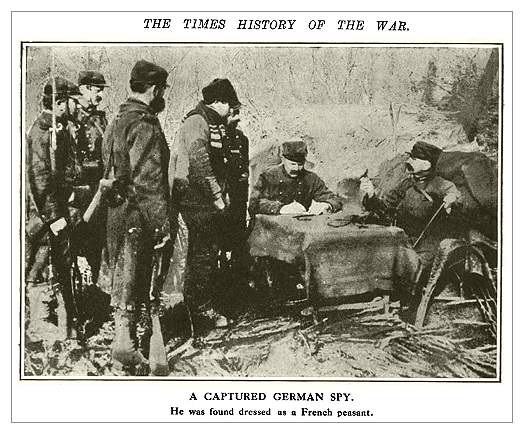
The Allies were no less prone to see spies behind every tree and bush.
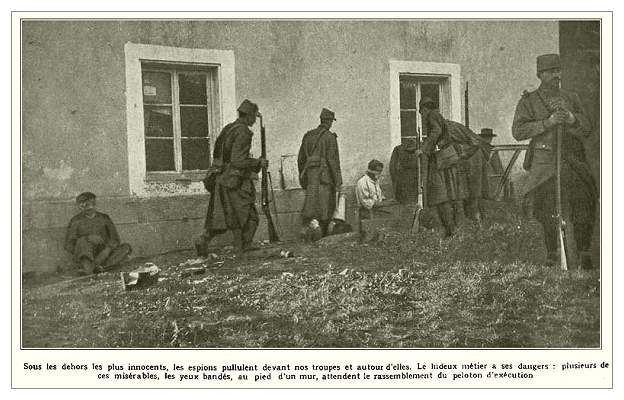
A condemned man awaiting execution by the French.
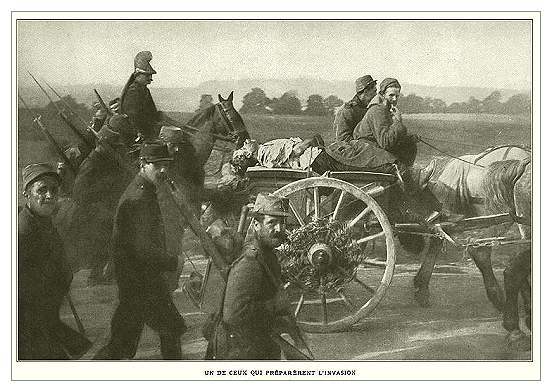
An executed spy.
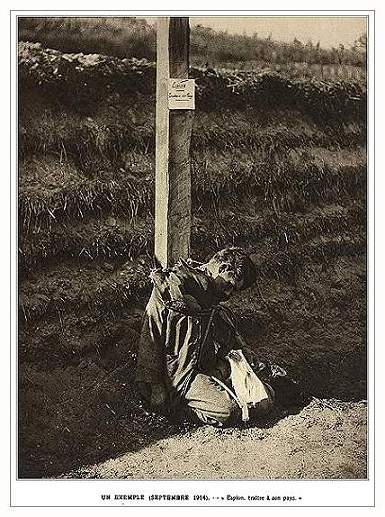
Another spy executed by the French.
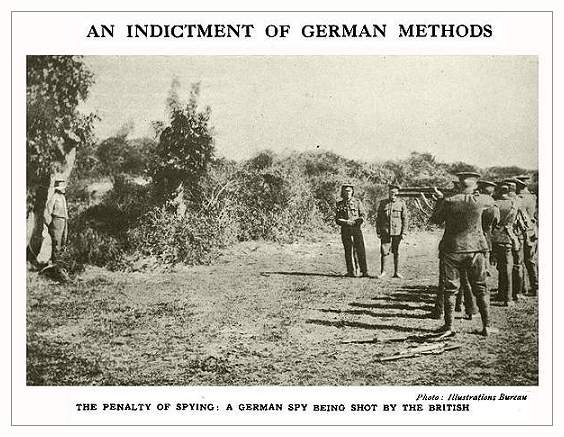
A British firing squad and an unlucky German spy.
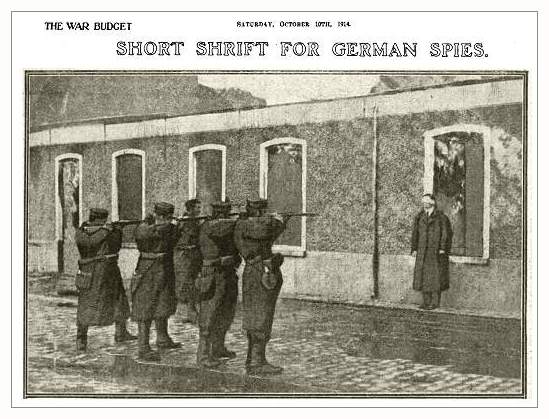
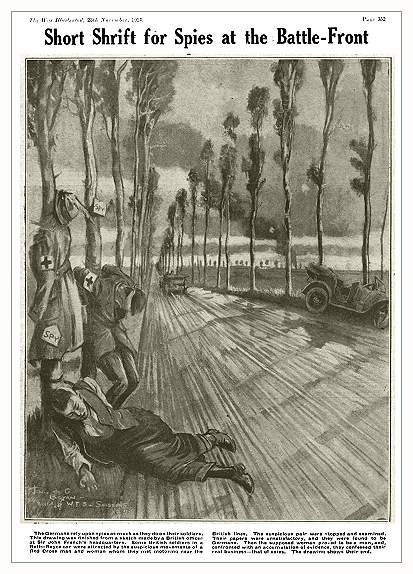
_________________________________________________
And yet spying was as much a part of war as anything else and went on in many forms. Here is a very believable account as told by an American Ambulance Field Service volunteer. The author was serving in Lorraine in 1915.
"I heard a story yesterday which I have every reason to believe is true. I give it to you as I got it:
Early one morning a soldier appeared in a boyau (communication trench) near here in the uniform of a genie (French engineer) and started chatting with some passing poilus. He told them he was inspecting the lines and they showed him round their trenches. On his tour, so to speak, he met some artillerymen, who asked him to lunch with their battery. He accepted, and after lunch wandered about the wood with his newiound friends, who showed him the position of many guns. As night came on, explaining he had to return to duty, he left his friends and went to the trenches. It was now dark and on getting to the first line, he told the sentry that he had orders to go out and inspect the barbed wire between the lines. As that was in accordance with the duties of a genie, the sentry let him go. The man never returned, and as, on inquiry, the company to which he said he belonged did not know him, there is little doubt he was a German spy."
From ‘Ambulance No. 10 : Personal Letters from the Front’ by Leslie Buswell (1915)